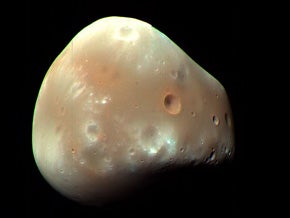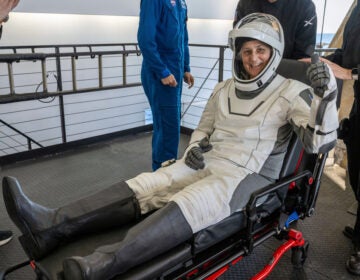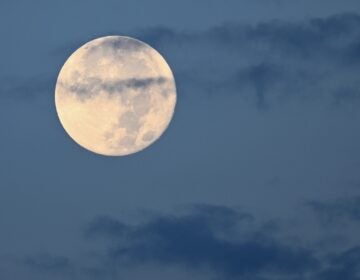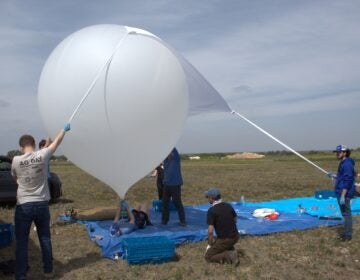Perseids pack peak punch tonight
ListenCount on an early setting moon, and with clear skies the peak of the annual Perseid Meteor Shower has the potential to be most memorable! While you’re out, also check out Saturn lowering in the west now, Venus never getting very high in the west anyway. Jupiter and Mars are still in the pre-dawn sky. It’s been one year since Curiosity landed on Mars. In that time, it has achieved its mission goal in proving that there definitely was an environment that could’ve supported primitive life on Mars in the distant past.
August 12, 2013
[Dave Heller] If you’re up for out of this world entertainment this evening, the Perseid’s performance reaches its peak tonight. Joining me with tips for viewing is Derrick Pitts, chief astronomer at the Franklin Institute. And Derrick, if it’s too late to travel from Center City, Philadelphia, what can urban viewers hope to catch?
[Derrick Pitts] What you might be able to see, if you at least get away from standing under a city light are the brightest members of the Perseid meteor shower. They won’t be anywhere near as frequent as the full showers members would be, considering that the shower will show us anywhere from 60 meteors per hour to 100 meteors per hour. So that means we’re going from, what, I guess 1 every minute to one every 30 seconds, if we look at the rate in that way. The best time to view the meteors tonight will be somewhere after sunset and before sunrise tomorrow morning. But you can increase your chances by starting later at night, after the moon has set. The moon sets at about 10 minutes of 11, I think it is. So we’ll have plenty of good, clear dark sky for the rest of the evening to observe, so if we’re out at about 11 or 12 or later, you can look over toward the eastern side of the sky, and we’ll be able to see the location from which the meteors are seeming to come from. This is not the strongest shower of the year, but the advantage of this shower is that it occurs in the summer and the outdoor temperatures are warm. Of course, it really does depend on having a clear sky. So if it’s cloudy, you won’t be able to see any meteors.
And if that’s the case, is there a consolation prize tomorrow and ensuing days?
The shower actually runs from late July through late August. So that means you will still be able to see Perseid meteors. However, the difficulty is that of course, the peak is tonight; the number of meteors seen per hour drops off dramatically as we reach the end of the week.
-

Photo by Flickr user Dave Dugdale
Hey, while we’re outdoors, what are some other easy targets to spot?
Well in the evening sky after sunset there’s Saturn and Venus over on the western side. Venus is over towards the west, Saturn is over toward the southwest. But Saturn’s much lower in the sky now than it was earlier in the season; and Venus, already being low in the sky, makes it a little more difficult to see but still there without much difficulty. And the two will approach each other as the rest of the month goes on. So they’ll eventually meet in September but you can watch Saturn as it lowers into the western sky continuing in its orbit around the sun combined with the motion of the Earth in its orbit around the sun. If we go around to the morning sky, of course, we can see Jupiter without much difficulty, and the Red Planet Mars high in the eastern sky, about an hour before sunrise. And of course as we move further on toward fall, our sunsets are coming earlier, our sunrises are coming later, that gives us more night sky. But the Red Planet will certainly standout just a step below Jupiter in the morning sky over in the east.
Folks lucky enough to view Mars should salute or wave to Curiosity, celebrating a one-year anniversary.
Yes indeed. We just passed the one-year anniversary of the safe landing of Curiosity on Mars. But not only did the rover land safely on the surface, but it’s conducted some really great science in just a year. In fact you could say that it’s already accomplished its mission, goal of proving that sometime in the past on Mars the environment was conductive to the development of primitive life. Have we seen anything? No, we’ve seen nothing. But now we’re certain that there were conditions present at least in one location where life could have developed. So the continuing mission of the rover over the next decade is to find more and more evidence that environments of this type exist elsewhere on the planet, particularly in that location where it’s working, continuring up the stream bed through Gale Crater to the top of Mount Sharp.
Review the necessary ingredients for life, or at least primitive life that may or may not have once existed on Mars.
Well, generally speaking, we’re looking for an environment that’s much more Earth-like. So we needed an atmosphere that was much denser than the current atmosphere is. We needed more moderate temperatures; instead of being below zero, the temperature needs to be much warmer. The atmospheric temperature needs to be much higher, again, a thicker atmosphere so water can exist as a liquid on the surface. And then we have to make sure that the water that was on the surface would be conducive to life in that the chemical make-up of the water is safe enough for life as we understand it, primitive life to develop. And these are the kinds of things that we’ve been able to identify using Curiosity looking at the stream beds that have been seen so far.
“Astronomer Asaph Hall this week 136 years ago identified the two moons, Phobos and Deimos. These are very small moons that orbit Mars, but his observations provided more information about the planet. “
Derrick Pitts
-

Martian Moon Deimos / NASA
Mars and all the strange and peculiar notions associated with it have existed for centuries, though it was only 100 years+ ago that we discovered its two moons.
Yes that’s true. Astronomer Asaph Hall this week 136 years ago identified the two moons, Phobos and Deimos. These are very small moons that orbit Mars, but his observations provided more information about the planet. We did not know that the planet had moons, we also did not clearly understand the mass of the planet, with is something else that he determined working as an astronomer with the US Naval Observatory’s telescope out of Washington, D.C. His information helped to provide more information, more factual information about the planet. There were lots of fanciful ideas about the planet Mars, as far as having canals that actually flowed with water and ships that moved up and down the canal so that the inhabitants could move goods and provide services all water-related. But of course these kinds of analogies made perfect sense when these moons were discovered in 1877. Because again, this is still how a lot of material was being moved on the surface of this planet. So it only made sense to make these analogies to sort of try to make Mars seem much like Earth. We have since come to realize that the surface is nothing like the planet Earth.
WHYY is your source for fact-based, in-depth journalism and information. As a nonprofit organization, we rely on financial support from readers like you. Please give today.




